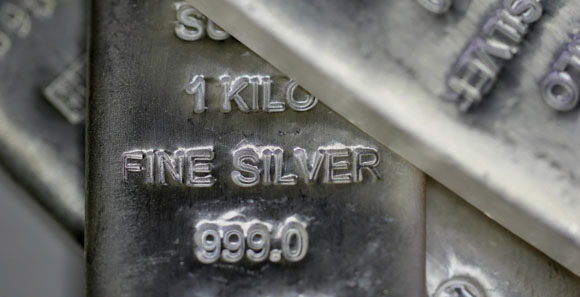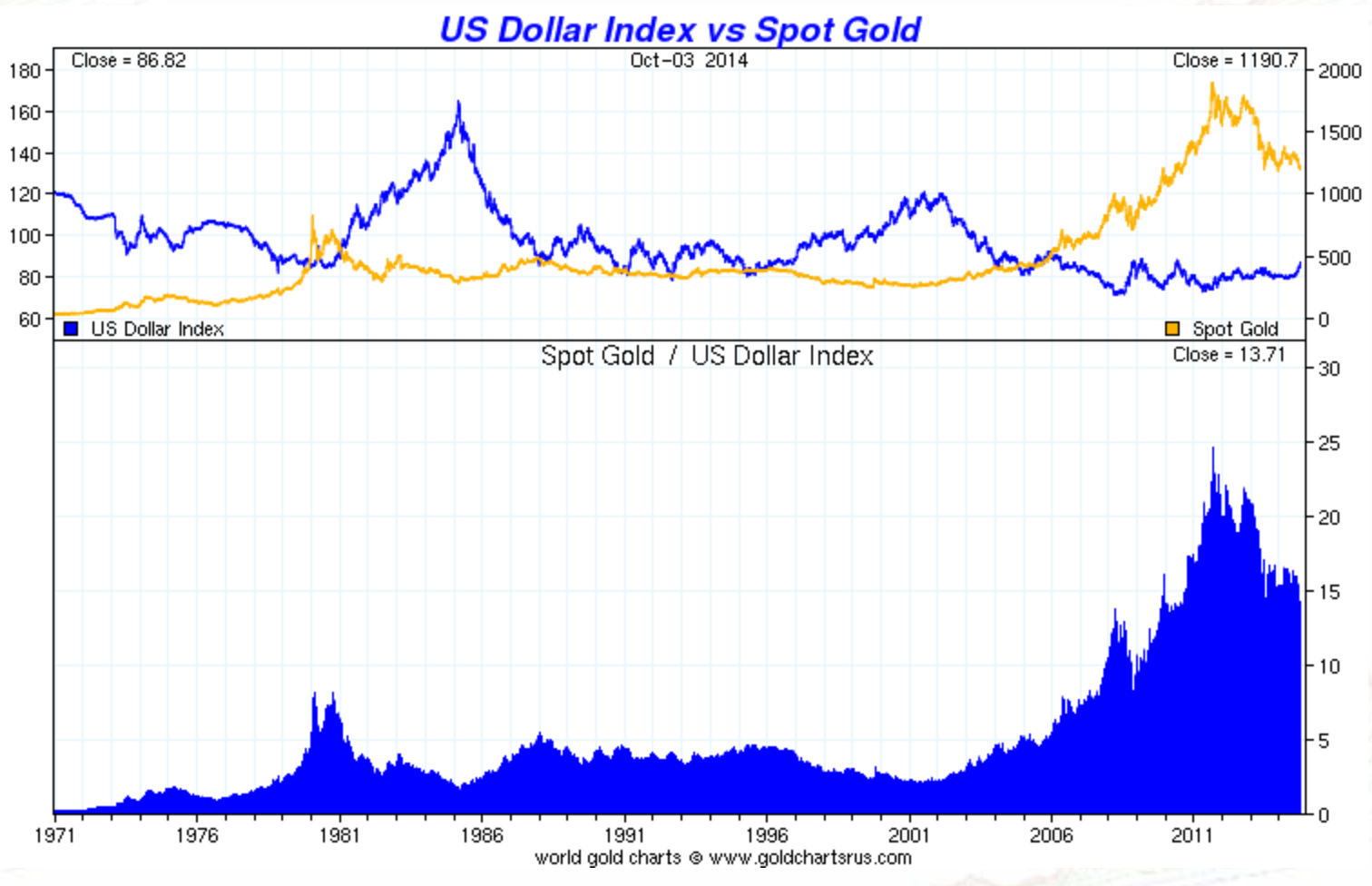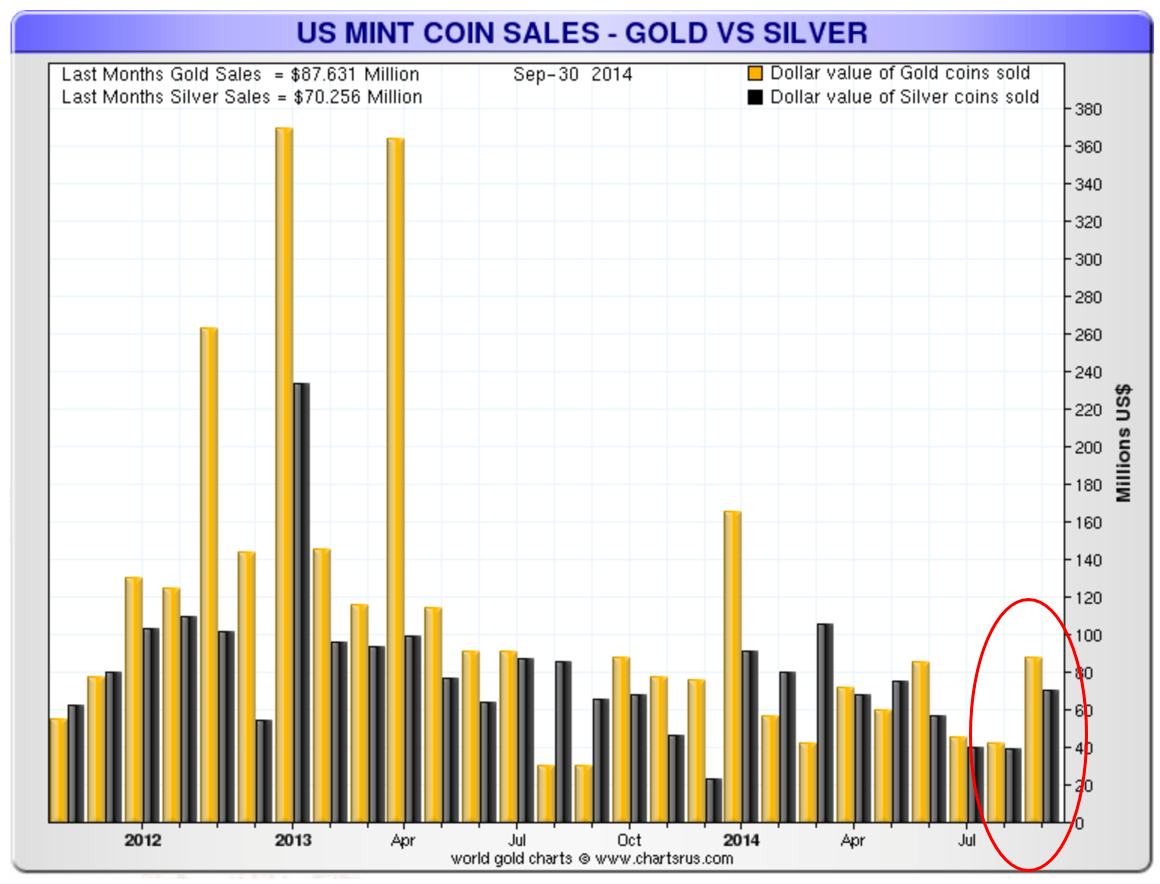 http://www.zerohedge.com/news/2014-10-10/brief-visual-history-metals
http://www.zerohedge.com/news/2014-10-10/brief-visual-history-metals
Saturday, October 11, 2014
The Calm Before The Storm In The Gold Market
US Dollar Index vs Spot Gold
Again this week the gold price tested the $1,200 level dropping below it on higher US dollar against most fiat currencies. It is assumed that a stronger US dollar against the euro and other fiat currencies is also negative for the price of gold. However gold is not a hedge against the US dollar but rather against all fiat currencies. Even though gold’s price has been falling, in India and China gold premiums have increased signifying a rising demand. We have also seen a substantial increase in silver and gold coin sales in the US. Actually gold coin sales doubled in September compared to August.
US Mint Gold Coin Sales – Gold and Silver
With sentiment at historic low as I explained in my previous article Gold Sentiment, $1,200 and more specifically $1,180 is more a correction within a secular bull market than a pause in a larger bear market. With more and more articles coming out with titles like “Gold Dies”, I am more convinced than ever that we are seeing a major bottom being crated. Eastern central banks are still buying massively and Western central banks are holding on to their stock. This doesn’t look to me as a continuation of a downtrend.
On November 30, Swiss citizens will go to the polls to vote on three areas; whether or not the Swiss National Bank should increase its gold reserves to 20%, that the central bank should stop selling its gold and that all its gold should be held within the country. If by any chance the Swiss people votes in favor I expect major tremors in the gold market. Just the fact that Switzerland will have to buy a large amount of gold to reach the 20% will have a major psychological effect on the gold market not to mention also the snowball effect it will have on other countries. Switzerland is a very small country but with a long history of gold ownership. A vote in favor in the Swiss Gold Initiative referendum would mean that Switzerland would have to buy 1,700 tonnes of gold. This represents 70% of annual world gold production. The Swiss National Bank has 5 years to acquire the 1,700 tonnes if the initiative passes.
Gold as a hard currency is also influenced by geopolitics. But for gold to go up you need not just a local crisis but a crisis that has global impact. Other ways it only increases in price locally in the conflict area with temporary impact on global price. With the Crimean annexation by Russia the world has switched from a détente and disarmament environment to a new cold war and rearmament. Local conflicts are appearing everywhere with potential of escalating into a global conflict. The Middle East and in particular the Iraq/Syria region has become a stateless land where ISIS is trying to expand its influence and destabilize the entire region. Libya, an oil rich country is still in chaos and now social unrest in Hong Kong is threatening stability in China. Let’s not forget the recent unrest in the US with the Ferguson riots, a suburb of St. Louis, Missouri. The US is not used to having social unrest on its own territory. Home grown terrorism spurred by economic hardship has not happened in the US since the 60s. There is a believe in the US that trouble can only come from the outside forgetting even the recent Oklahoma City bombing by a good American boy named Timothy McVeigh. In Europe high unemployment, the rise of the extreme right and secessionist movements (Scotland, Catalonia, etc.) threaten the European Union.
The currency wars are still alive and contrary to the G8 agreement not to manipulate their exchange rates, this is what is actually happening. The US dollar going up against the euro is a stated desire of the European Central Bank. But there is no reason why gold should move with the euro. Gold is the anti-fiat hard currency not just the anti US dollar. Gold has risen as much in all paper currencies in the last 15 years not just against the US dollar. In the most recent Fekete Research Gold Basis Service, Sandeep Jaitly states that “December silver remains in backwardation and December gold is soon to join it”.
In a recent article in the London Financial Times, John Dizard mentioned an increase in gold’s “popularity as a medium of exchange for international transactions has been soaring, particularly in the past few months as the impact of US government sanctions on non-compliant banks has become severe.” And that,despite gold being “the most expensive and least convenient of all of the monetary alternatives to the dollar.” I emphasize the words “medium of exchange” and “soaring” because if we believe the mainstream media nobody wants to use gold as money because it is expensive and least convenient. I mentioned it in a previous article on gold sentiment but I wanted to mention it again because I think it is a very important piece of information.
Physical gold is being accumulated and used in exchanges but very discretely as of now. In a recent report mentioned in the UK Telegraph it is revealed that a record number of super-rich elite are buying gold bullion bars weighting 12.5 Kg. The report says “The gold buying secrets of the UK come as it was recently revealed the number of 12.5kg gold bars being bought by wealthy customers has increased 243% so far this year, when compared to the same period last year.”
The geopolitical and economic environment in the last few months was in my view the calm before the storm. All the economic issues both in Europe and the US and all the geopolitical conflicts I mentioned above, or a combination of them have the potential to degenerate “unexpectedly”. Both the economic and political environments are uncertain and will surprise the complacent markets. More and more the current environment reminds me of the Citigroup president’s statement to the Financial Timesbefore the 2008 crisis. CEO Chuck Prince made clear that he was aware of the risks his company was taking but said “When the music stops, in terms of liquidity, things will be complicated. But as long as the music is playing, you’ve got to get up and dance. We’re still dancing,”
An unexpected precipitating event like a black swan event in this uncertain environment will push gold and silver up with a quantum leap with gold leading.
Wednesday, October 8, 2014
David Morgan's Secret to Being Grateful, Even at $17 Silver
Manipulation and apathy can't keep silver prices down forever; there is too much demand and too much money sitting on the sidelines. In this interview with The Gold Report, Silver-Investor.com Editor David Morgan tells us why he is grateful for his balanced approach to investing and life. He also explains why he is still excited about four developers that are moving projects forward at any price.

The Gold Report: A recent GFMS/Thomson Reuters Silver Institute World Silver Surveyshows that while the price of silver dropped 23.6% in the last year, there was actually an increase in demand, particularly from China and India. Why is the price so low when the fundamentals seem to point otherwise?
David Morgan: As the survey shows, there was a deficit of silver, which means fundamentally the price should be higher. But real prices are determined in the paper markets and the pressure there has been downward.
Additionally, the large physical silver holding companies—Sprott Physical Silver Trust (PSLV:NAR), Central Fund of Canada (CEF) and the Zurich Cantonal Bank, the silver ETF—have not purchased any quantities of bullion in quite some time. That begs the question of why these big, traditionally bullish entities aren't stepping in at these low silver prices.
"Excellon Resources Inc.'s all-in costs are down to almost $16/oz through the first half of the year."
The other question investors are asking is, "When is this going to turn around?" They get depressed and say, "I can't win because the manipulators always win. It's pointless to be in this market." That mindset has taken hold of a lot of people who were once very bullish in the silver market.
This is all proof that we're very close to the bottom, if not at the bottom. When sentiment is this low, people become fearful. As Jim Dines says, the cure for low prices is low prices. It won't go on forever, even though it may seem that way now.
TGR: What price are you using for silver when you evaluate companies? Do you pencil in what the fundamentals say the price should be or the psychologically beaten down price of the paper market?
DM: We go with the market, which right now is saying $17 an ounce ($17/oz). The market cannot be argued with; the price is what it is. Regardless how it got there, manipulation or not, it is what it is. We use the 90-day average price because it's a standard in most industries and tends to smooth out the fluctuations. We might not agree with what the market is saying, but that's immaterial to our analysis. Our analysis has to be based on what the market is showing.
TGR: Is there a tipping point where the silver price is so low that even non-silver bugs start to see it as an entry point and come into the market?
DM: There are plenty of people, including money managers, who understand that this is a great price. They are just waiting for the right moment to bite. It usually starts with someone nibbling at the market and starting to accumulate. Or, someone sells aggressively to test the market for the absolute low. The Rothschilds were notorious for this type of market test and probably the first to do so in a manner that the public became aware of such tactics. They sold something they wanted to buy to force the price down so they could start accumulating at the very bottom. Either way, there will come a point where savvy buyers will start accumulating again.
TGR: Do those sorts of tests happen in the silver market more because it's smaller and more volatile both on the upside and the downside?
DM: I wouldn't say that kind of market activity happens more frequently, but I would say it's more effective in the silver market because it doesn't take a lot of selling or buying pressure to move the market. It would be more difficult to have the same impact with a large, liquid stock like Google Inc. (GOOG:NASDAQ), for example.
"Silver Wheaton Corp. has significant organic growth taking place."
TGR: Is there a tipping point where the silver price is so low that companies can't afford to produce it?
DM: Yes and no. The reality is that there are actually very few pure silver operations. As much as 70% of the silver produced is an offtake of mining for base metals. These producers really don't give a hoot about the price of silver. As long as they're making money in copper, lead and zinc, they don't pay attention to the silver price. They will keep producing no matter how low the silver price goes.
Even primary silver producers are reluctant to turn off the lights temporarily when they are working at a loss. I figure the average all-in sustaining cost per ounce, including taxes, is $23/oz. That makes selling for $17/oz unsustainable. But in the long run, operating minimally at a loss for a few months actually makes more sense than halting production. There are many reasons. Customer and employee contracts would result in big fines if not fulfilled in some cases. Also, keeping the wheels turning is important because mines deteriorate rapidly. A lot of them have to be dewatered, monitored for structural integrity and generally maintained. It actually might cost more to shut down and restart later than run it at a loss for a year as an example.
TGR: Is high grading taking some of the edge off that loss? Is that going to have an effect a couple of years from now on the number of Indicated resources left when prices are higher?
DM: Any company that has the ability to high-grade right now is doing it to squeeze out any profit possible. Some companies are in a better position than others. When gold was $1,900/oz, some mined the lower-grade ore that cost them, for example, $1,600/oz all-in costs and took that profit, leaving the $1,100/oz or lower higher grade for a rainy day when margins are tight, such as what we are experiencing now.
The general trend, however, has been toward lower grade resources. We have a finite planet and the easy stuff is targeted first. It's true in oil, it's true in metals. The grades being mined now are grades that were not considered worth mining three decades ago. But there is very little high grade left, so companies go after whatever can be done profitably.
TGR: With prices at this level, are fully funded developers in a better situation than explorers or producers?
DM: Some developers are in better situations than explorers and producers. This, however, is always the case as the quality of an asset typically goes hand-in-hand with the ability to raise financing. One developer we are quietly bullish on is Bear Creek Mining Corp. (BCM:TSX.V), as we think the government of Peru will return the Santa Ana project in full.
"Trevali Mining Corp. has plans to bring on several new mines over the next three years."
We also still like Trevali Mining Corp. (TV:TSX; TREVF:OTCQX; TV:BVL), which is technically a zinc-lead-silver producer but has plans to bring on several new mines over the next three years, starting with the Caribou mine and mill in New Brunswick in 2015.
Zinc is going to be in short supply in the next few years. A number of large zinc mines will be closing down in the near future and there will be a deficit of a material that is used in everything from gutters and electrical appliances to galvanizing steel. It may not be as sexy as silver, but it is important to our everyday lives and pretty soon there won't be enough of it to go around. The Morgan Report saw that a few years ago and picked Trevali as the best way to leverage that trend.
Another great example of a developer being in a better situation than many explorers and producers is Guyana Goldfields Inc. (GUY:TSX), which is now fully funded for construction of the Aurora project in South America. It was able to secure the proper financing rather easily because the quality of its asset.
One of the lowest cost producers, Excellon Resources Inc. (EXN:TSX; EXLLF:OTCPK), is trimming fat at the La Platosa mine in Durango, Mexico. All-in costs are down to almost $16/oz through the first half of the year. The new Mexican royalty tax has taken a toll on all mining companies in 2014. Other premier, low-cost producers such as SilverCrest Mines Inc. (SVL:TSX; SVLC:NYSE.MKT), First Majestic Silver Corp. (FR:TSX; AG:NYSE) andFortuna Silver Mines Inc. (FSM:NYSE; FVI:TSX; FVI:BVL; F4S:FSE) have also been negatively impacted, with all-in costs increasing in 2014.
TGR: Last time we chatted, you talked about the benefits of royalty companies. Have they been able to maintain profits in this environment? Are some doing better than others?
DM: Royalty companies have seen profits fall, but far less than mining operators. This has to do with production growth making up for lower metal prices. Some royalty companies are doing better than others, but we are really only talking a few.
Silver Wheaton Corp. (SLW:TSX; SLW:NYSE) has significant organic growth taking place with Goldcorp Inc.'s (G:TSX; GG:NYSE) Peñasquito silver mine in Mexico finally operating close to capacity. Plus, Vale S.A.'s (VALE:NYSE) Salobo copper mine expansion in Brazil is ramping up. Add to that Goldcorp's San Dimas mine minimum threshold increasing from 3.5 million ounces (3.5 Moz) to 6 Moz. In addition, Hudbay Minerals Inc.'s (HBM:TSX; NYSE) Constancia project in Peru should reach production in the fourth quarter. Silver Wheaton has just begun to see its next phase of growth.
Franco-Nevada Corp. (FNV:TSX; FNV:NYSE) has its sights set on something big. That is why it just raised $500 million in equity financing when it already had more than $1 billion in the bank. Short term, a production start at True Gold Mining Inc.'s (TGM:TSX.V) Karma gold project in Burkina Faso at the end of 2015 will boost Franco-Nevada's royalties. Long term, the largest and most valuable stream comes on-line with First Quantum Minerals Ltd.'s (FM:TSX) Cobre Panama copper production start in 2018.
Royal Gold Inc. (RGLD:NASDAQ; RGL:TSX) is witnessing a huge growth spurt from its cornerstone asset, a 52.25% gold stream on Thompson Creek Metals Co. Inc.'s (TCM:TSX; TC:NYSE) Mt. Milligan copper-gold mine in British Columbia. Beyond that, there are no sizeable assets in the pipeline with the exception of Barrick Gold Corp.'s (ABX:TSX; NYSE) controversial Pascua-Lama project in Chile. Still, Royal Gold has ample liquidity and could take advantage of new opportunities from companies that need help moving projects forward.
TGR: As companies are cutting costs, are some parts of the world more attractive than others?
DM: Absolutely. The Frasier Institute publishes a Survey of Mining Companies each year that assesses things like taxes and regulations all over the world. Mexico was at the top of the list for some time, but the new mining tax there bumped it down. I also like Chile and Peru. What I really like are conglomerates that are spread over a number of geographic locations. For instance, Pan American Silver Corp. (PAA:TSX; PAAS:NASDAQ) has mines in lots of jurisdictions. If there is a problem with a mine in Peru, the investor is protected because the mine in Mexico is still viable. Billion dollar market caps are safer partly because of the diversified jurisdictional risk.
TGR: You are going to be speaking at the Cambridge House Silver Summit in Washington this month. What words of wisdom do you have that will help put things in perspective at a time when a lot of investors are feeling stressed?
DM: First, people need to keep in mind that prices go up and down in all markets. Second, know that the fundamentals of owning precious metals have not changed. Third, remember why they bought the metal in the first place. And lastly, ensure that they are diversified properly, meaning they need to own the right amount of physical metal for their age and objectives. We don't advocate 100% or even 80% allocation to precious metals. But we want the money investors to put into the sector to be profitable, and that is why we specialize in sharing information about this sector.
A couple of years ago when silver prices had similarly dropped before bouncing up again, I talked at the Silver Summit about being grateful that I even have a portfolio to worry about. I shared some statistics on how the average American lives compared to the average citizen of the world. It was a reminder to myself and the audience that sometimes we get too focused on the monetary aspects of our lives.
Money is important, but it needs to be put in the proper place. There is more to life than how much money you can make. Nature preaches balance and when things get out of balance, it has a way of bringing them back into equilibrium. This is most evident in the natural resource sector. We're acting as if the earth is income rather than capital. The result is that we are using up our base capital in the form of forests and water and metal and not replacing them. That is unsustainable. I'm afraid we are going to pay a high price for that. We need to live within our means rather than getting all we can. It's more about what you can contribute, maintain and sustain than who has the most toys.
TGR: Thank you for sharing that.
 David Morgan (www.Silver-Investor.com) is a widely recognized analyst in the precious metals industry; he consults for hedge funds, high net-worth investors, mining companies, depositories and bullion dealers. He is the publisher of The Morgan Report on precious metals, the author of "Get the Skinny on Silver Investing" and a featured speaker at investment conferences in North America, Europe and Asia.
David Morgan (www.Silver-Investor.com) is a widely recognized analyst in the precious metals industry; he consults for hedge funds, high net-worth investors, mining companies, depositories and bullion dealers. He is the publisher of The Morgan Report on precious metals, the author of "Get the Skinny on Silver Investing" and a featured speaker at investment conferences in North America, Europe and Asia.
Subscribe to:
Posts (Atom)


